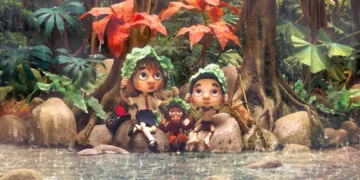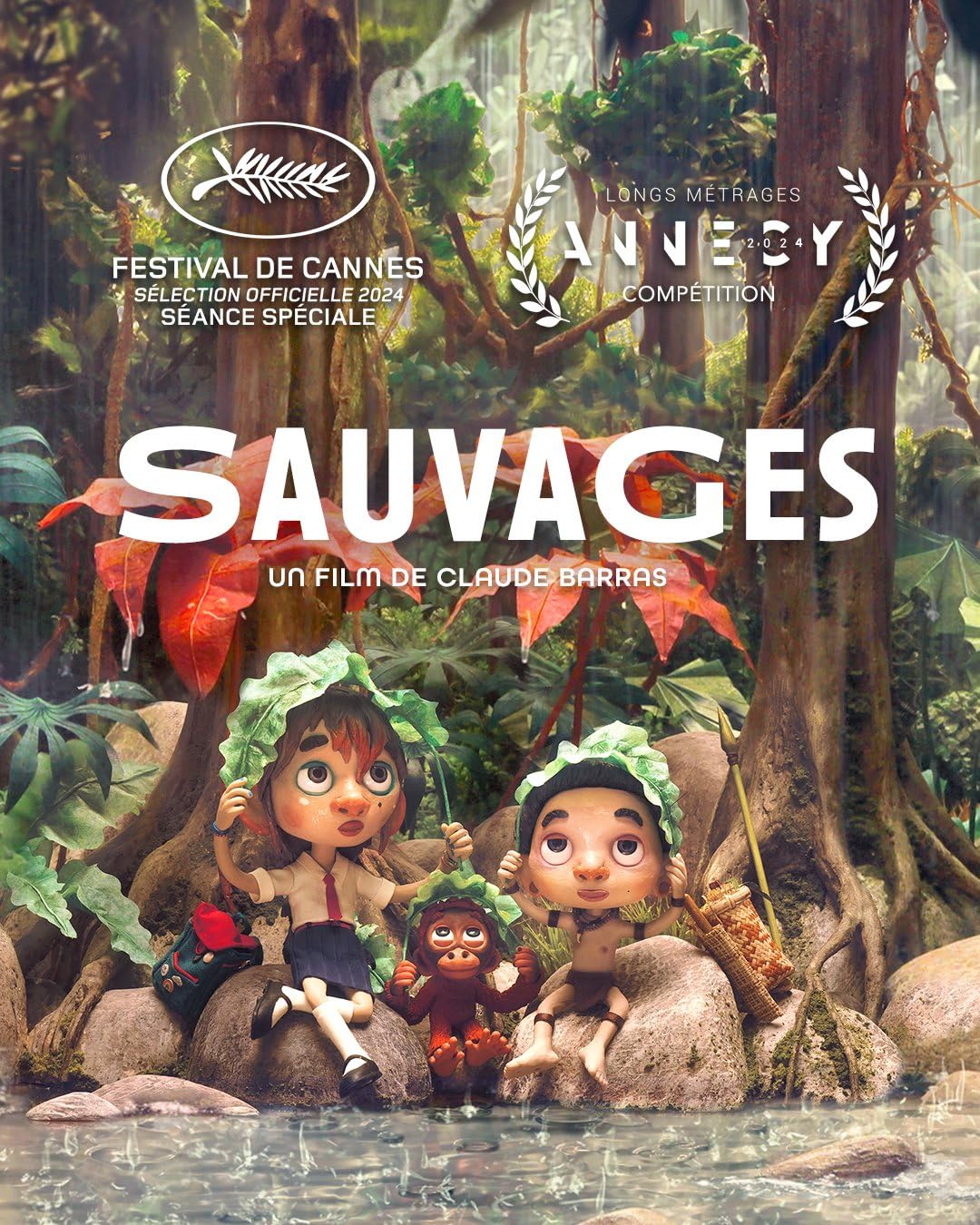The animated film Savages transports viewers to the lush rainforests of Borneo through its intricately crafted stop-motion animation. Directed by Claude Barras, the French film follows an 11-year-old girl named Kéria, who discovers her cultural heritage ties to the Penan, an indigenous group fighting to protect their ancestral forest lands.
As the movie opens, breathtaking imagery introduces the dense jungles of Borneo. Delicate details bring the ecosystem to life, from colorful plantlife to animals like a baby orangutan rescued from harm. But impending threats loom as logging operations clear sections of forest. We meet Kéria, living near the forest with her father while dealing with her late mother’s Penan background. When her cousin Selaï comes to stay, fleeing conflict over the forest, their time together in the woods opens Kéria’s eyes to the beauty of the land and the struggle to preserve it.
Barras crafts a compelling story with timely themes of environmentalism, cultural identity, and standing up against exploitation. Through Kéria’s journey of self-discovery, the film advocates for protecting the forests and indigenous rights in a thoughtful yet passionate manner.
Her Forest Journey
The animated film Savages tells its impactful story through the eyes of young Kéria. Growing up in a town near the dense Bornean rainforest, Kéria barely knows of her heritage tied to the Penan people. When her cousin Selaí comes to live with her, fleeing conflict over the forest, it sets her on a journey of discovery.
Selaí, who comes from fully living within the forest’s depths, opens Kéria’s perspective. She sees how connected he remains to the land and its ways, even enjoying bullying the sheltered city girl. But Kéria also cares for the baby orangutan she rescued, naming him Oshi and finding her own bond. After the cousins quarrel, Selaí flees into the wilderness with Oshi, forcing Kéria to follow deep into the dense greenery.
Among the towering tree trunks and lush plantlife, Kéria learns skills for surviving off the land and connects with her culture in new ways. As she helps Selaí return to his people, the film renders vibrantly the forest’s textures and sounds. Yet dangers also emerge, from poisonous snakes to prowling big cats, showing nature’s edge. Kéria gains not just woodland knowledge but a growing respect for the Penan’s forest-focused way of life.
When at last meeting Sela’s tribe, Kéria discovers more about her late mother and family ties to this place. Wishing to protect the forest as her kin have for generations, she joins their fight against the palm oil developers’ encroachment. The story follows her transformation from a disinterested city girl to someone willing to take a stand as she finds belonging with her cultural group and cares about their threatened home.
Through tender moments like breastfeeding baby animals yet also depicting real perils, the film immerses viewers in the rainforest world to argue its message: that protecting indigenous lands and culture matters. By grounding this in one girl’s journey of self-realization, it crafts an impactful tale of environmental activism.
Natural Wonders Brought to Life
The animated film Savages dazzles with its breathtaking visualization of the Bornean rainforest. Director Claude Barras leveraged the wonders of stop-motion animation to transform this lush natural world into a vibrant, moving canvas.
Viewers find themselves immersed within dense greenery, towering trees stretching towards the sky. Delicate plants spill across the forest floor in lush coats of every imaginable hue. But it’s not just the flora that astounds; animals also appear to have been crafted with incredible care.
You can’t help but fall for the wide-eyed charm of baby orangutan Oshi. Subtle motions bring this furry creature to life, from curious glances to sneezes that reveal his playful spirit. Less cute beasts inhabit the woods too, shown with impressive veracity. Sinuous snakes slither through foliage, panthers prowl with predatory poise.
It’s clear immense affection went into sculpting each leaf and creature. Barras admired this ecosystem’s interconnected natural order, and it radiates from the screens. Even scarier denizens like leeches wriggle with a certain biological realness. Viewers truly feel transported alongside the film’s young leads deep into an untamed primeval world.
If animals appear endearingly real, humans take on a slightly more exaggerated look. Wider eyes and rounder faces distinguish Kéria and others from their wild rainforest co-inhabitants. This visual divergence hints at a disconnect between people and place, a gap the film argues must be bridged.
Through its animations, Savages spreads vital messages of environmentalism and cultural respect. By bringing the aesthetics of Borneo’s forests to such stunning cinematic life, it inspires viewers to appreciate and protect these rare natural wonders.
Honoring Heritage, Healing the Land
Savages carries important thematic messages that resonate long after viewing. At its core, the film advocates for protecting the ancestral home of the Penan people from corporate destruction.
We see how the palm oil company disrespects their nomadic way of life, trying to frame indigenous customs as “primitive” or thrust modern ideals upon them. But Barras ensures viewers understand the deep connection the Penan have to the forest—it’s integral to their entire culture and identity.
As Kéria rediscovers her own Penan roots, she understands the value of tradition and belonging. The land holds ancestral wisdom that outsiders cannot replace. Barras presents this indigenous perspective in a thoughtful, never preachy manner.
Colonial overtones also emerge as faceless executives wield power over the Penan, threatening violence if they don’t comply. But the film finds humanity even in adversaries, avoiding simple villainization. Overall, it conveys respect for all cultures seeking self-determination.
On environmental issues, Savages walks a balanced line. It highlights the tropical forest’s natural magnificence without sugarcoating ecological dangers. And the palm oil company’s destruction feels all too real—a sobering reminder of how corporate priorities overrun common resources.
Most impressive is how Barras brings such complex topics to younger viewers. The story engages through Kéria’s journey rather than didacticism. By the film’s end, its messages of cultural sensitivity and environmental responsibility feel inspired yet never forced. Savages proves thoughtful themes can indeed reach all ages.
Not Your Typical Cartoon
Savages stands apart from many animated environmental films in its thoughtful handling of important issues. Where some movies aim their message at kids, Barras creates something that engages viewers of any age.
Take The Lorax, for example; its warnings on pollution weren’t wrong, but the overall story felt geared towards younger kids. Savages avoid feeling too simplified. Though its themes are serious, Barras presents them accessibly without dumbing anything down.
The film is equally thoughtful in depicting the Penan people. All too often, indigenous cultures get tokenized or turned into caricatures on screen. But Barras clearly did his research, showing the Penan’s deep spiritual connection to the rainforest in a sensitive, grounded way.
Contrast this with how wildly inaccurate many movies portray Native cultures. One need only recall the many problems with Pocahontas to see that Disney completely missed the mark. Savages gets it right by working closely with its real-life subjects.
What results is a fable that feels vitally important yet is never preachy. Barras doesn’t shy away from difficult topics but keeps the focus on character. We explore the conflict through Kéria’s eyes rather than through overt messaging.
In the end, Savages offers a more mature animated experience. While entertaining, it sticks with viewers as a work of art that aims to start meaningful discussions. For Barras, animation is about much more than just enchanting children.
The Forest Echoes On
Savages leaves a real impression with its heartfelt defense of nature. Barras crafted something urgent yet soothing, a rallying cry that stays with you.
The film carries such weight because it feels wholly authentic. Its dramatic story draws us in but stays grounded, its characters realistic not idealized. We fully buy into Kéria’s awakening thanks to Barras’ humane touch.
Most striking is how seamlessly Barras weaves important ideas into a gripping narrative. The Penan’s plight feels tragically real, their way of life portrayed with grace not sentimentality. Its environmental warnings feel stirring not dogmatic.
I’d recommend Savages to anyone wanting an animated film that stays with them. Barras made something special that will introduce even young minds to pressing issues in a thoughtful way. Its beauty shines a light on unsung heroes our world badly needs.
After the final frames, the film’s message lingers as powerfully as the memory of that lush Bornean forest. Barras proves animation truly has the power to start discussions and open hearts to causes worth fighting for. The environmentalist spirit of the Penan certainly carries on in its wake.
The Review
Savages
Claude Barras' Savages proves animated films can tackle weighty issues with grace and nuance. Blending breathtaking scenery with rich characters, it brings an enlightening environmentalist story to audiences worldwide. Barras treats both nature and indigenous culture with immense respect, crafting an experience that stays thought-provoking with viewers. For its beauty, bite, and thoughtful championing of causes worth fighting for, Savages has my highest recommendation.
PROS
- A stunning stop-motion animation that brings the rainforest to life
- Thoughtful, grounded portrayal of indigenous Penan culture
- A strong environmental message is presented easily without being preachy.
- Well-developed protagonists help viewers engage with the themes.
- Timely story highlights real issues surrounding deforestation
CONS
- More development could have been given to some secondary characters.
- Complex indigenous dialogue isn't subtitled for non-Penan viewers.
- Darker themes may be intense for very young children.

















































